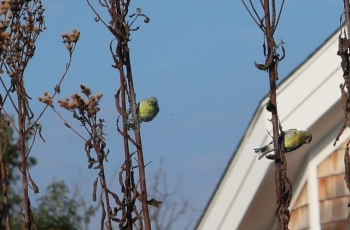
From your kitchen window, the fall and winter landscape may look like a messy yard. But for robins, chickadees, finches, cardinals, juncos, and nuthatches, your yard may look like survival.
Though we humans may enjoy birds’ frenetic, colorful activity surrounding winter feeders, bird feeders don’t take the place of native trees, shrubs, dead-head flowers, sticks, or logs.
Many birds need the protein they get from insect eggs, larvae, and chrysalises, all found in leaf litter, fallen sticks, and rotting logs. Birds also forage deep inside the branches of shrubs and trees, out of human sight. They seek weather protection among inner branches of evergreens such as white pines, arborvitae, and spruce trees.
In a bird’s world, the backyard birdfeeder is only one element of the bigger picture. Some birds decide to overwinter here only if they find suitable winter habitats.
“There are many different factors that go into birds’ decision to overwinter over or not, but the availability of food is essential,” says Colchester resident Robert Tougias, author of Birder on Berry Lane (Charlesbridge, 2020) and a birding columnist.
“Abundant seed heads are key for species wintering here from the north, such as juncos and our non-migratory American goldfinch,” Tougias says, noting, “Homeowners are more likely to attract and retain birds if they have fruit-bearing trees and shrubs on their land.”
He lists the nomadic cedar waxwing, eastern bluebird, and the robin among birds that convert to a diet that includes fruit each winter.
According to a 2011 study by Susan Smith and Scott McWilliams at the University of Rhode Island, some of the best fruiting shrubs for migratory songbirds are arrowwood viburnum, pokeweed, Virginia creeper, highbush blueberry, bayberry, and shadbush. See the National Audubon’s native plant finder for birds attraction by zip code at www.audubon.org/native-plants.
As for those standing stalks that some people hesitate to leave, Tougias points out that when snow begins to accumulate and the ground is covered, brown seed heads can be a lifeline for some species.
Get the full story and lots of links to helpful resources at Zip06/TheDay.
